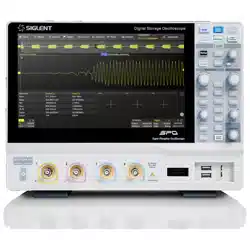Loading ...
Loading ...
Loading ...

SDS2000X HD Series Digital Oscilloscope User Manual
4 4 i n t . s i g l e n t . c o m
EXT/5:5x attenuation of external trigger channel
AC Line: AC mains supply
D0~D15: Digital channels
Trigger coupling: Coupling mode of the current trigger source. It is only valid when the trigger source
is C1~C4, EXT, or EXT/5.
DC: All the signal’s frequency components are coupled to the trigger circuit for high-frequency
bursts or where the use of AC coupling would shift the effective trigger level.
AC: The signal is capacitively coupled. DC levels are rejected. See the datasheet for details of
the cut-off frequency.
HFR: Signals are DC coupled to the trigger circuit, and a low-pass filter network attenuates high
frequencies (used for triggering on low frequencies). See the datasheet for details of the cut-
off frequency.
LFR: The signal is coupled through a capacitive high-pass filter network, DC is rejected and low
frequencies are attenuated. For stable triggering on medium to high-frequency signals. See the
datasheet for details of the cut-off frequency.
Trigger mode
Auto: The oscilloscope will sweep without a set trigger. An internal timer triggers the sweep after
a preset timeout period so that the display refreshes continuously. This is helpful when first
analyzing unknown signals. Otherwise, Auto functions the same as Normal when a trigger
condition is found.
Normal: Sweeps only if the input signal meets the trigger condition. Otherwise, it continues to
display the last acquired waveform.
Single: Stops the acquisition and displays the last acquired waveform.
Trigger level: The source voltage level or levels that mark the threshold for the trigger to fire. Trigger
levels specified in Volts normally remain unchanged when the vertical gain or offset is modified.
Trigger type: See the chapter "Trigger" for details.
Loading ...
Loading ...
Loading ...
